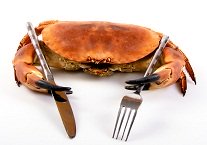Alaska Crab Fishing
Alaska crab fishing is the most significant, most intense and most dangerous of the Alaskan commercial shellfish industries. The waters of Alaska, notably the Bering Sea, Bristol Bay, Dutch Harbor, the Kodiak and Aleutian Islands are home to rich bounties of crabs: tanner, (Alaskan Snow Crab), Dungeness Crab and the famed Alaskan King Crab. Alaskan King Crab season, as well as, Opilio crabbing seasons run in the cold, treacherous winter months from October through January.
The different varieties of the Alaskan crabs possess great commercial value and the Alaskan King crab in particular is a prized dish in the culinary world. They can be valued as high as caviar and French wine! U.S. and Japanese restaurants are the primary importers of Alaskan King Crab in the world.
An idea of the valuation of this crab fishing can be garnered from the fact that a seasoned fisherman can hope to catch $50,000, or more, worth of crab in about an eight-week period. This makes for long, hard, and tedious working days!
Alaska King Crab Beginnings
The commercial crab fishing industry in Alaska had its beginning way back in 1950. The returns were promising from the very start and the region quickly attracted hundreds of U.S. fishing boats with a vision of quick prosperity.
The 1980's were the "roaring 20's" of crab fishing in Alaska. During this early period of crab fishing, the fishing boat captains regularly earned $150,000 in a single season and the crab fishing boats boasted of saunas, music systems and microwaves.
But by 1983, the Alaskan King crab industry crashed for no apparent reason. As the worst slump in fishing history, it forced fishermen to look into alternative fishing sources. Thus Alaskan commercial fishing branched out either to salmon and halibut or bairdi and opilio, two types of tanner crabs (also known these days as Alaskan Snow Crab which is highly popular on buffets in restaurants world wide.
Since then the Alaska crab fishing trade has been looking up a bit with the year 2001 bringing in 23.2-million pounds of fishing stock worth over $36,000,000.
King Crab fishing still continues to command the highest pay packet in the
world.
The Con's of King Crab Fishing
Making good money is the only "rosy side" of the job. Alaska crab fishing is one of the most dangerous jobs in the world. To fish for crabs in the glacial waters of the Arctic Ocean or the Bering Sea in sub-zero temperatures, with pounding waves thrashing on the deck and tossing the fishing boats treacherously and icy winds howling continuously, needs a stout heart and an able and healthy body. Furthermore, your work will involve negotiating the enormously large crab pots and coils and coils of line along a slippery ship deck.
Each and every muscle and sinew of the body is stretched to the limit and exhaustion to the point of breakdown. This is common work for those who work in the Alaska crab fishing industry. Crippled limbs, crushed fingers, broken ribs and broken legs are the staple fare in the grueling 20-21 hour daily schedules, or more. Not to mention, men toppling overboard into the Bering Sea is not uncommon incidents, either. In fact, there are casualties in these fishing trips every year.
In spite of all the possible hardships, there is no shortage of men (or women, these days) seeking employment in this fishing trade who don't mind "working on the edge". Alaska crab fishing remains, to this day, a much haloed job to land and worthy of deep respect.
If you think you're up to the task, check out our Alaska Crab Fishing Jobs page and learn more details about landing a crab fishing job.
Stay in the know and updated with what's happening in the crabbing industry by visiting and bookmarking Crab Fishing News.
Go back up to the top of Alaska Crab Fishing
Go to Crab Homepage and learn more about crab and find tons of delicious recipes!
|
|


New! Comments
Have your say, ask a question, or at least say hello! Leave us a comment in the box below.